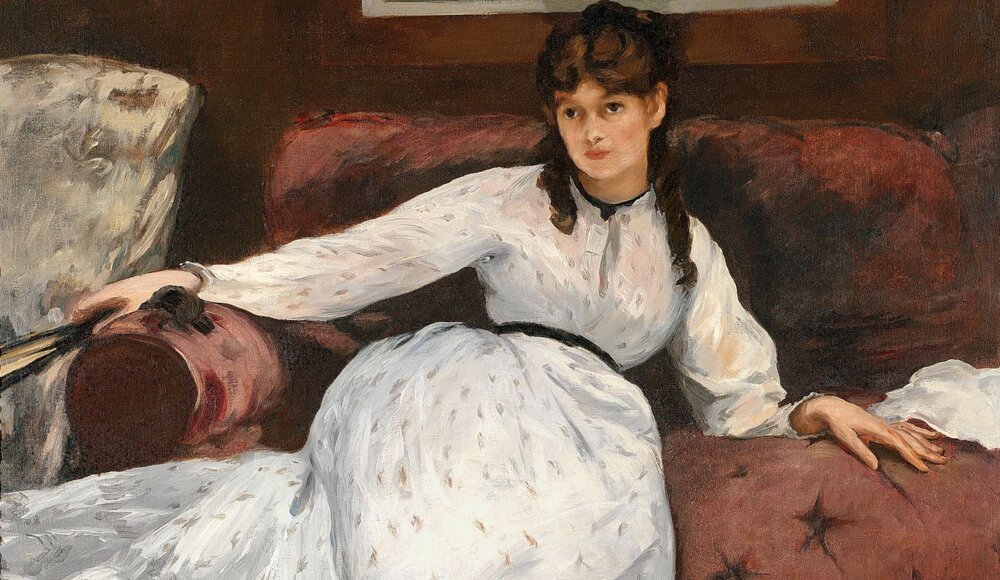The famous Irish poet and novelist George Moore said of her: "Her paintings are the only paintings by a woman that could not be destroyed without leaving a gap in the history of art.".
Let's go back in pictures on the extraordinary destiny of an artist with revolutionary ambitions.

Edouard Manet, Berthe Morisot with a Bouquet of Violets, 1872. Musée d’Orsay, Paris.
1. She was the heiress of Fragonard
Nothing predestined Berthe Morisot, a little girl from the conservative Parisian bourgeoisie, to become the artist we celebrate nowadays. Nothing... except a particularly impressive family tree. Her paternal grandmother, Elisabeth Duchêne, is none other than the great-niece of the illustrious Jean-Honoré Fragonard. His daring, light and naughty painting opens a breach in the conformist trajectory of Morisot's descendants.

Jean-Honoré Fragonard, The Bolt, circa 1777. Louvre Museum, Paris.
There’s no doubt that Berthe inherited from this frivolous uncle, a great ancestor of the Impressionists by the choice of his subjects and by his deep study of light effects. Indeed, Fragonard was also a revolutionary in his time. By choosing to paint frivolous themes and scenes of intimacy, he voluntarily turned his back on the Academy, which imposed genre, mythological or religious scenes.
2. Some say that she had a secret relationship with Edouard Manet
Because she was a charming woman in a men's community, Berthe Morisot seduced many suitors. More or less famous and wealthy, many have succumbed to the magnetism of her black eyes: Henri Fantin-Latour was among the first, Puvis de Chavanne was the most persistent, but it’s also said that she had a secret relationship with Edouard Manet, the superstar of Modern Art, who also became one of her closest friends.
He painted 11 portraits of the young lady, some of which show curious details, blurring the contours of their relationship. At once colleague, muse, and sweetheart (for some), the depth of their relationship will remain a mystery, an enigma filled with ambiguities, even for the most obstinate biographers.

Edouard Manet, Berthe Morisot (The Rest), 1869. Rhode Island School of Design Museum (US).
In the end, it was Eugène Manet, Edouard's brother, who obtained her precious favors. They married in 1874: she was 33 years old; he was 41. This late marriage was far from the standards of the time. Eugène Manet was a devoted and attentive husband for Berthe: because he was an income earner, he used all his available time to help his wife. He accompanied her to paint outdoors, he took charge of framing and hanging her artworks in exhibitions, he defended her interests by negotiating with collectors and dealers, he participated in the smooth running of the Impressionist calendar: efficient and perceptive, he stepped aside to leave space. A salutary and uncommon behavior for the time. Thanks Eugène!
3. Her sister was also a painter
Berthe Morisot had a brother, Tiburce, a soldier about whom little is known. Above all, she had two older sisters: the oldest was named Yves (an odd name for a woman), and the other, two years older than Berthe, was named Edma. Berthe and Yves didn't have much in common, they even had some difficulties to communicate. On the other hand, Berthe was very close to Edma: they were both animated by the same ardor, the same passions for culture. Piano and painting were their main fields of interest.

Berthe Morisot, Edma Morisot Reading, 1867. Cleveland Museum of Art (US).
Edma was very talented, and Berthe was sometimes jealous of her style. Unfortunately, when she married, Edma had to give up her dreams of being an artist to devote herself to her routine as a wife and mother. A common tragedy in Europe at the end of the 19th century.
4. She was a close friend of all the Impressionists
Among the Impressionists, Berthe was never an anonymous muse, nor even a benefactress at the service of the gentlemen's success. Berthe was an outstanding artist: her presence was considered necessary, and her companions were all aware of it. Degas, however, known for his legendary misogyny, said about her "We find that the name and talent of Miss Berthe Morisot are too much for us to do without.".

Berthe Morisot, Peasant Girl Among Tulips, 1890. Dixon Gallery, Memphis (US).
She participated in most of the exhibitions organized by the group (7 out of 8), both in the organization and in the exhibition of her work. After having established an ambiguous relationship with Manet, she became close to Edgar Degas (a loyal friend with a sincere critique), then to Auguste Renoir (who became the drawing teacher of her daughter, Julie Manet), as well as Claude Monet (whose style and ambitions were more in line with Berthe). Like her partners in the artistic revolution, she too would submit to the stylistic exercises of this new movement: like Manet, Monet, and Cézanne, she too would produce a "Déjeuner sur l'Herbe" (Luncheon on the grass).

Paul Cézanne, Le Déjeuner sur l'Herbe, 1876. Musée de l'Orangerie, Paris.
5. She wasn't the only woman of Impressionism
Among the Impressionists, Berthe Morisot is the feminine personality that history remembers the most. But she wasn't the only one! In fact, there were 4 of them: Eva Gonzales, who was Manet's student after Berthe. The two women politely hated each other, each reproaching the other for monopolizing all the attention of the master. Then there's Marie Bracquemond, wife of Felix Bracquemond, artist and friend of the Impressionist group. The first died at 36, not having enough time to express the full extent of her virtuosity, and the second was forced to abandon her vocation to become the discreet wife and mother her husband wished for. Two immense talents sacrificed on the altar of fate and patriarchy.

Edouard Manet, Portrait of Eva Gonzales, 1869-1870. National Gallery, London.
The third lady is more like Berthe: she's independent and dedicated her whole life to painting, without ever giving in to concessions. Her name is Mary Cassatt. Of American origin, it was Edgar Degas who integrated her into the group. Despite similar themes (interior scenes, maternity scenes), the styles of these two women remained profoundly different. Although they were not friends, they appreciated each other: and so goes life.

Mary Cassatt, Little Girl in a Blue Armchair, 1878. National Gallery of Art, Washington DC. Lovely posture..!
6. She inspired Claude Monet to paint the Waterlilies
It's one of the best kept secrets in the history of Art, and for good reason: we have lost track of the original artwork signed by Berthe. According to the few writings that circulate on the subject, it was a white waterlily suggested by a few pencil strokes. Berthe Morisot had made this sketch to illustrate a prose poem by her great friend Stéphane Mallarmé.

Berthe Morisot, The Cradle, 1872. Musée d’Orsay, Paris.
The poet was also a friend of Monet, and it’s known that they both had the opportunity to contemplate a copy. Mallarmé regularly recounted how much this drawing had fascinated Monet: from then on, we know, as history tells us, that this fascination for waterlilies would never leave him again. Unfortunately, Berthe didn’t have the opportunity to discover the creative ardor of the master of Impressionism in front of these aquatic flowers: she died before he started his first series of Water Lilies.
And that's it, it's over. And since one cannot tell a whole life story in a few writings, Berthe Morisot's story is bound to hold other surprises. Fascinating artist by her audacity and her delicacy, the trajectory of her life is the image of impressionism: a sweet revolution that will mark history forever.

Berthe Morisot, Lady at her Toilette, 1875. Art Institute of Chicago (US).
Did you know that?
Like many women artists (except Frida Kahlo), Berthe Morisot suffered for many years from the underestimation of her artwork in comparison to her male contemporaries. However, this offense is about to be repaired, since in 2013, one of her paintings ("After Breakfast") reached highs at an auction (6.98 million pounds / 8.15 million euros). This is still far from the results achieved by paintings by Monet, Manet, or Renoir, but this record places her above other famous Impressionists (Pissarro, Sisley, Boudin...), and her value is only going up. A fair return for an uncompromising woman whose style has nothing to envy to her fellow friends.

Berthe Morisot, After Breakfast, 1881. Private collection.
If you're interested by women's trajectories in the history of art, we recommend you to read these two articles: 4 Extraordinary Badass Women who Changed the (very patriarchal) History of Art (Vigée Le Brun, Kahlo, Saint Phalle, Gentileschi), and 4 Women Artists Overshadowed by their Husband's Fame (Jo Hopper, Sophie Taeuber-Arp, Margaret Keane, Lee Krasner).
And if impressionism stimulates your curiosity, discover without delay our impressionist saga: The Inspirations of Impressionism (EP.1), the Birth of Impressionism (EP.2), the Personalities of Impressionism (EP.3). You'll discover many fascinating stories, as well as some cross-references and unpublished infographics on the subject.


 Bastien Alleaume
Bastien Alleaume